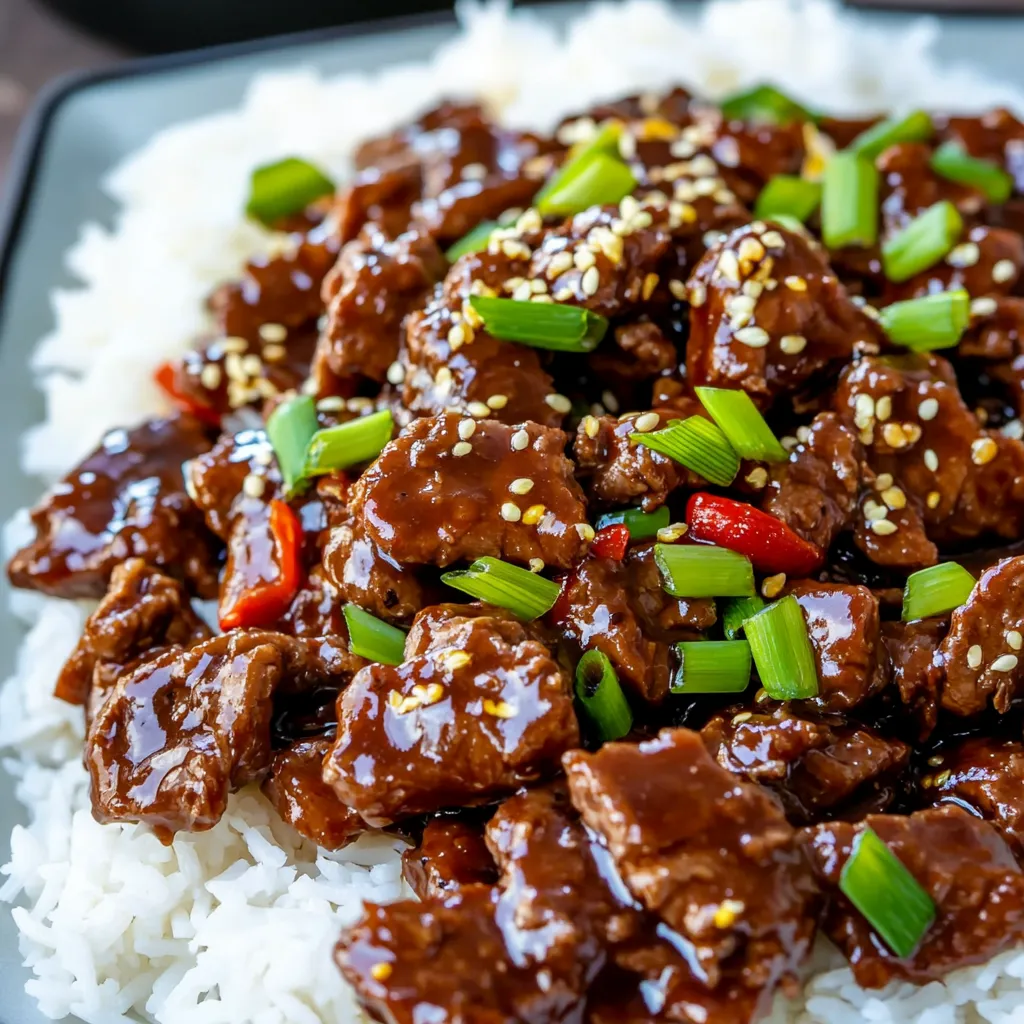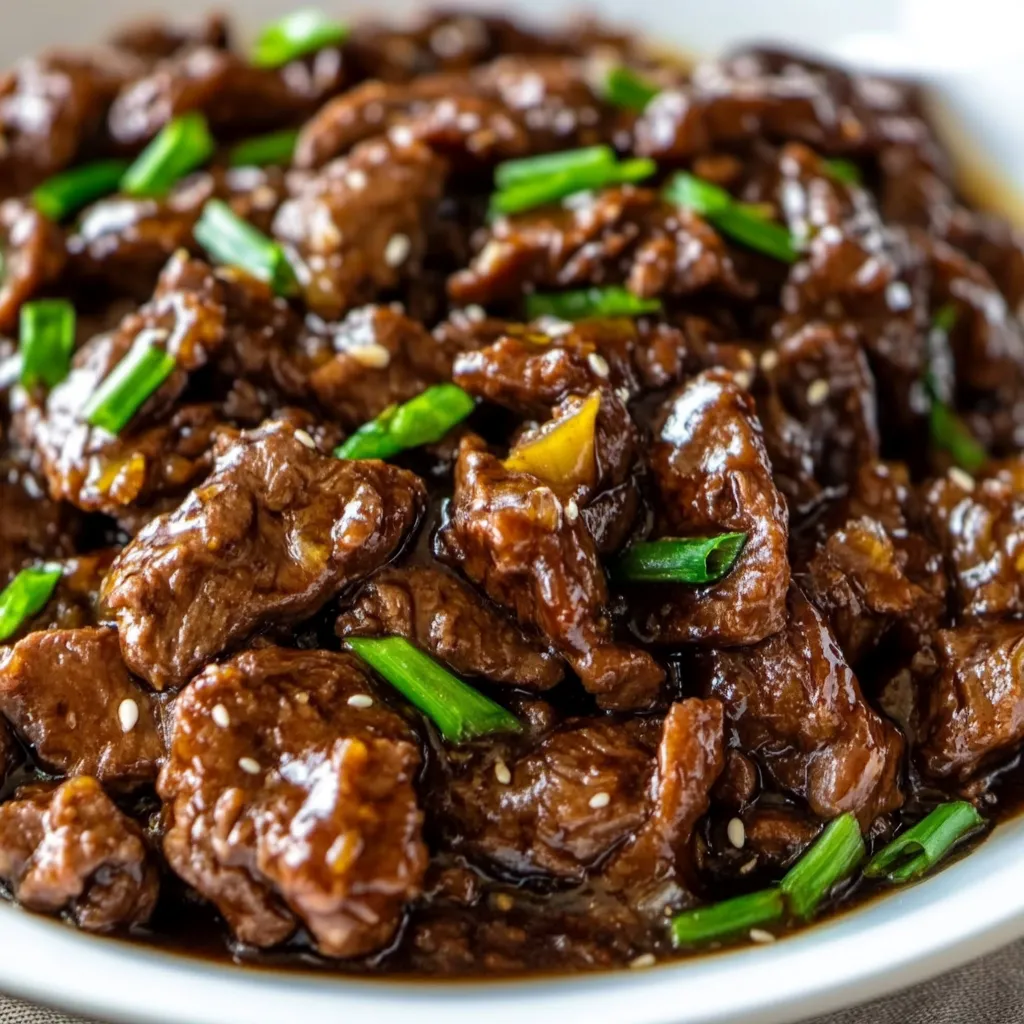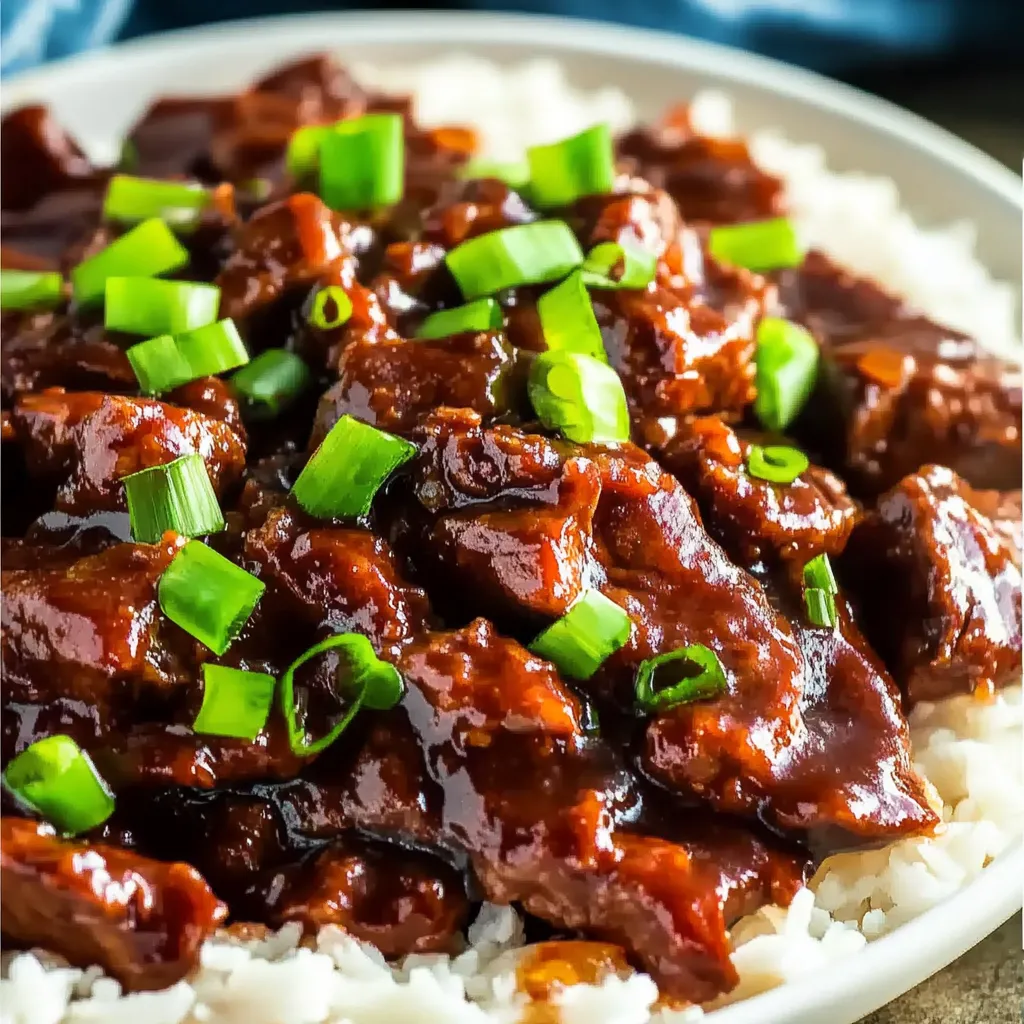If you’re a fan of rich, savory flavors and easy, no-fuss recipes, Slow Cooker Mongolian Beef will quickly become one of your go-to meals. This dish brings the irresistible taste of Mongolian-style beef right into your home, offering tender beef slices cooked in a sweet and savory sauce made from soy sauce, brown sugar, and a hint of ginger and garlic. What makes it even better is that it’s prepared in a slow cooker, allowing the flavors to fully develop while you go about your day.
Not only is this recipe simple and satisfying, but it also mimics the flavors you might find at your favorite Chinese takeout spot. With a perfect balance of sweet, salty, and aromatic flavors, this Slow Cooker Mongolian Beef is a comforting dinner for busy weeknights or weekend gatherings. Best of all, it takes minimal effort to make, leaving you with more time to relax.

Why Choose a Slow Cooker for Mongolian Beef?
Cooking Mongolian Beef in a slow cooker is the ideal way to make this dish. The slow cooking process allows the flavors to blend beautifully, and the beef becomes tender and juicy, easily absorbing the rich, savory sauce. Plus, using a slow cooker means you don’t have to stand over the stove, making it a perfect option for a hands-off meal that you can enjoy without spending hours in the kitchen. Whether you’re a busy professional, a parent, or simply someone who enjoys a stress-free cooking experience, this recipe is tailored to fit into your lifestyle.
Ingredients for Slow Cooker Mongolian Beef
To make this Slow Cooker Mongolian Beef, you’ll need a few simple yet essential ingredients. The flavor profile of this dish is built around a few key elements that complement the beef beautifully.
Main Ingredients:
-
Flank Steak: This is the most commonly used cut for Mongolian beef. It’s affordable, tender when sliced thinly, and holds up well during slow cooking.
-
Garlic and Ginger: These two ingredients bring the signature flavor to the dish. They offer a warm, aromatic base that infuses the beef and sauce.
-
Soy Sauce: Provides the salty umami flavor that’s essential to the recipe. Opting for low-sodium soy sauce helps control the salt level in the dish.
-
Brown Sugar: Adds a touch of sweetness that balances out the saltiness of the soy sauce, creating a perfectly harmonious sauce.
-
Cornstarch: This ingredient helps thicken the sauce, giving it a silky, glossy finish.
-
Sesame Oil: Adds a rich, nutty flavor that enhances the overall taste of the dish.
-
Water: Used to dilute the sauce and ensure the beef is tender after slow cooking.
-
Green Onions: Freshly chopped green onions are added at the end to bring a bit of freshness and color to the dish.

Tips for the Best Slow Cooker Mongolian Beef
To ensure that your Slow Cooker Mongolian Beef turns out perfectly, consider these helpful tips:
1. Choose the Right Cut of Beef
While flank steak is the traditional choice, you can also use skirt steak, hanger steak, or sirloin. However, flank steak tends to work best due to its texture and flavor.
2. Use Low-Sodium Soy Sauce
Opting for low-sodium soy sauce helps keep the dish from being too salty. Since soy sauce is the main source of salt in this recipe, it’s essential to choose a lower-sodium version for better control over the overall flavor.
3. Thicken the Sauce
If you prefer a thicker sauce, mix 1 tablespoon of cornstarch with 2 tablespoons of cold water in a small bowl. About 30 minutes before serving, pour this mixture into the slow cooker and stir to thicken the sauce.
4. Add Spice for Extra Heat
For a bit of extra heat, consider adding crushed red pepper flakes or a sliced red chili along with the green onions. This will give your Mongolian beef a spicy kick that enhances the flavors.
5. Make It Ahead of Time
Like most slow cooker dishes, Slow Cooker Mongolian Beef can be made ahead. Store leftovers in an airtight container in the fridge for up to 3 days. The flavors will continue to develop, making it even more delicious the next day.
Variations of Slow Cooker Mongolian Beef
While the traditional Slow Cooker Mongolian Beef recipe is a classic, there are several variations you can try to suit your tastes, dietary preferences, or available ingredients. These variations allow you to enjoy the dish in new ways while maintaining the core flavors that make Mongolian beef so delicious.
1. Slow Cooker Mongolian Beef with Chicken
For those who prefer a lighter protein, Slow Cooker Mongolian Beef with Chicken is a great alternative. Chicken breast or thighs work wonderfully in this recipe, and the slow cooking method ensures the meat stays juicy and flavorful.
-
How to make it: Use boneless, skinless chicken breasts or thighs, and slice them into thin strips, just like you would with flank steak. Follow the same instructions, and cook the chicken on low for about 4-5 hours.
-
Why it works: Chicken absorbs the sweet and savory sauce just like beef, but it offers a lighter option for those looking for a healthier meal.
2. Vegetarian Slow Cooker Mongolian “Beef”
For a plant-based version of this dish, consider using vegetarian substitutes such as tofu or tempeh. These alternatives soak up the sauce beautifully and create a satisfying, hearty dish.
-
How to make it: Use extra-firm tofu that has been pressed and cut into bite-sized cubes or tempeh for a more substantial texture. Coat the tofu or tempeh in cornstarch before adding it to the slow cooker, just like you would with beef.
-
Why it works: Tofu or tempeh absorbs the flavors of the soy sauce and brown sugar sauce, offering a plant-based version of the original recipe that still feels indulgent.
3. Slow Cooker Mongolian Beef with Veggies
Incorporating vegetables into your Slow Cooker Mongolian Beef can add extra flavor, texture, and nutrition. Vegetables like bell peppers, carrots, and mushrooms complement the sweet and savory sauce, making it a more well-rounded dish.
-
How to make it: Add your choice of sliced bell peppers, carrots, and mushrooms to the slow cooker along with the beef. These vegetables will soften and infuse the sauce with added flavor while providing extra color and nutrients.
-
Why it works: The vegetables not only add freshness but also balance out the richness of the beef and sauce, making the dish even more comforting.
4. Spicy Mongolian Beef
If you enjoy a bit of heat with your meals, adding some spice to your Slow Cooker Mongolian Beef is an easy way to elevate the flavors.
-
How to make it: Add red pepper flakes, chili paste, or fresh sliced chilies along with the garlic and ginger. If you prefer a more subtle heat, start with a small amount and taste-test as it cooks.
-
Why it works: The spice complements the sweetness of the brown sugar and the savory soy sauce, creating a delicious balance of flavors that adds a new dimension to the dish.

Best Sides to Pair with Slow Cooker Mongolian Beef
To create a complete, satisfying meal, pairing Slow Cooker Mongolian Beef with the right sides can enhance the flavors and balance the richness of the dish. Here are some of the best sides to serve with this delicious recipe:
1. Steamed White or Brown Rice
A simple, fluffy rice is the perfect companion for Mongolian Beef. The rice will absorb the flavorful sauce, making each bite satisfying and filling.
-
Why it works: The mild flavor and texture of rice complement the bold flavors of the beef and sauce, allowing the Mongolian beef to shine.
2. Vegetable Stir-Fry
A vegetable stir-fry is a great way to add more nutrition to your meal. You can stir-fry broccoli, snap peas, and carrots with a dash of soy sauce and sesame oil for an easy, healthy side dish.
-
Why it works: The freshness and slight crunch of the vegetables provide a great contrast to the tender, saucy beef. Plus, the stir-fry adds extra color and texture to the plate.
3. Asian Cucumber Salad
A light and refreshing Asian cucumber salad is an excellent side to balance the rich flavors of the Mongolian beef.
-
Why it works: The crisp, cool cucumber paired with a tangy dressing (made with rice vinegar, sesame oil, and a touch of sugar) offers a nice contrast to the warmth and richness of the beef. It’s the perfect palate cleanser.
4. Garlic Butter Noodles
For an indulgent side, serve garlic butter noodles with your Mongolian beef. The buttery noodles are a delicious way to soak up the sauce from the beef.
-
Why it works: The richness of garlic butter noodles pairs beautifully with the savory, sweet Mongolian beef sauce, making every bite more decadent.

Slow Cooker Mongolian Beef Recipe
Ingredients:
-
1 ½ pounds flank steak, thinly sliced against the grain
-
¼ cup cornstarch
-
1 tablespoon toasted sesame oil
-
1 teaspoon minced garlic
-
1 teaspoon minced ginger
-
½ cup low-sodium soy sauce
-
⅓ cup brown sugar
-
½ cup water
-
½ cup green onions, cut into ½-inch pieces
Instructions:
-
Prep the Beef: Slice the flank steak thinly against the grain. Place the sliced beef in a bowl with cornstarch and toss to coat evenly.
-
Prepare the Sauce: In a separate bowl, combine sesame oil, minced garlic, minced ginger, soy sauce, brown sugar, and water. Stir to mix well.
-
Combine in Slow Cooker: Add the cornstarch-coated beef into the slow cooker. Pour the sauce mixture over the beef, making sure it’s well-coated.
-
Cook the Beef: Cover and cook on HIGH for 2-3 hours or on LOW for 4-5 hours. The beef should be tender and easily shred with a fork.
-
Add Green Onions: Stir in the green onions towards the end of the cooking time. Let them cook for the final 10-15 minutes.
-
Serve: Serve the Mongolian beef over steamed rice or noodles, and garnish with additional green onions if desired.
Notes:
-
Slicing Tip: Freeze the flank steak for 20-30 minutes before slicing it to make it easier to cut into thin strips.
-
Soy Sauce: Opt for low-sodium soy sauce to control the salt content in the dish.
-
Cornstarch: Ensure the beef is well-coated in cornstarch to create a glossy sauce when it cooks.
-
Substitute: You can substitute flank steak with skirt steak, sirloin, or hanger steak.
Nutritional Facts (per serving):
-
Calories: 308 kcal
-
Carbohydrates: 23g
-
Protein: 30g
-
Fat: 9g
-
Saturated Fat: 3g
-
Cholesterol: 81mg
-
Sodium: 629mg
-
Potassium: 557mg
-
Sugar: 14g
-
Vitamin A: 100 IU
-
Vitamin C: 1.9mg
-
Calcium: 52mg
-
Iron: 2.9mg



